I found this edition of the PHotoEspaña festival amazingly good. One of the most thought-provoking shows, Committed Places, Topography and the Present, displays the work of ten photographers who use the genre of topography photography as a medium to go beyond the representation of physical places and reflect on a series of social, historical or political issue. These photographers know how to work their public: first you grab their attention with a spectacular or intriguing image then you tell them the story that lurks behind the print. Some of the participating artists were familiar to me (Geert Goiris , Walter Niedermayr and Taryn Simon) but i discovered other photographers worth a mention and some praise:
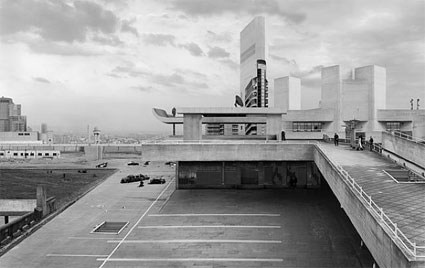 Beate Gütschow, S #22
Beate Gütschow, S #22
The show opens with Beate Gütschow‘s puzzling B&W S series (the S is short for Stadt, or “city”). What looks like vaguely familiar, yet slightly post-apocalyptic, urban spaces are in fact digital assemblages of details from the artist’s archive of images of buildings, people, and concrete structures seen in Chicago, Los Angeles, Sarajevo, Kyoto and other urban environments.
The depressing urbanscapes are inhabited by small human figures who are actually the only element we recognize: they are mostly tourists, homeless people or drug addicts.
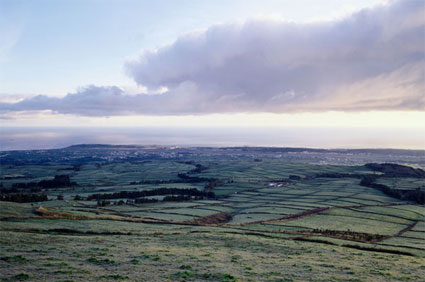
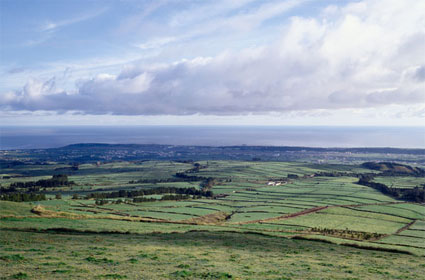 From the series 3.16
From the series 3.16
On March 16, 2003, Spanish Prime Minister Jose Maria Aznar, UK Prime Minister Tony Blair and US President George W. Bush met in The Azores (Portugal) to reconfirm their intention to continue the war on terror that took a stern turn after 9/11. The distressing images of the New York tragedy have been broadcast over and over again on TV in all their spectacularity and pathos. This stress put on the importance of the deaths occurred in New York is somewhat at odds with the abstract images of fireworks diffused by the same tv stations to illustrate the Gulf War. Augusto Alves da Silva went to the Azores and shot eleven photographies between 7 am and 7 pm. 3 as each of the planes of Blair, Aznar then Bush landed, the others were taken before and after. As in 1991, the massacre that was decided on this meeting is not shown. Instead we have the idyllic images of the Azorean landscape.
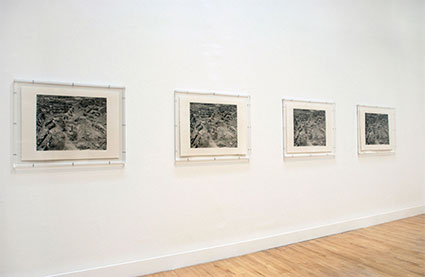 Simon Starling: One Ton II, 2005; installation view, Turner Prize 2005, Tate Britain
Simon Starling: One Ton II, 2005; installation view, Turner Prize 2005, Tate Britain
I almost missed what is probably the most fascinating piece of the exhibition: a series of 5 identical medium-size images. Simon Starling‘s One Ton, II aims to raise our awareness on energy consumption and in particular the huge amounts of energy used to produce tiny quantities of platinum.
Both the subject matter and its mode of production strikingly allude to the fact that one ton of ore, mined from the South African open cast mine pictured in the images, was needed to produce Starling’s five platinum prints.
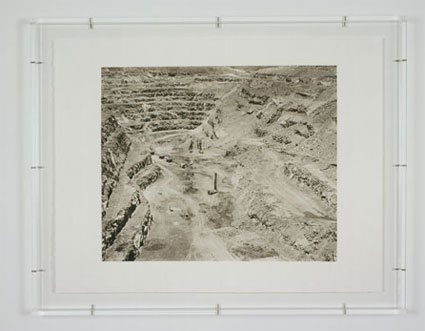
One Ton, II suggests also that art cannot be totally dissociated from the complex networks of historical, economic, and geopolitical forces that bring it into existence.
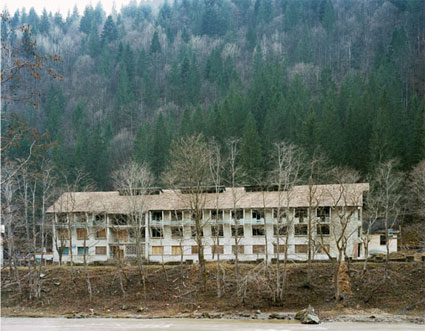 The Borgo Pass, 3. From the series The Travel of Jonathan Harker
The Borgo Pass, 3. From the series The Travel of Jonathan Harker
Themain (albeit invisible) protagonist of Joachim Koester‘s pictures is Count Dracula. The photographer embarked on a trip to the Bargau Valley (Transylvania), the very location where Bram Stoker situated Dracula’s Castle, Jonathan Harker‘s ride against the wolves and the final crumbling to dust of the nasty vampire. Stoker never visited Transylvania, he researched the setting of his novel in the comfy environment of the reading rooms of the British Museum.
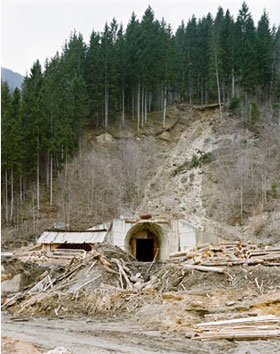 The Borgo Pass, 2. From the series The Travel of Jonathan Harker
The Borgo Pass, 2. From the series The Travel of Jonathan Harker
Koester’s photos invite us to a journey that roughly follows the steps of Jonathan Harker but has more to do with suburban sprawls and kitsch tourist industry than ghoulish “undeads”. Instead of the “bewildering mass of fruit blossoms” described in the novel, what can be find at the outskirts of Bistrita is more like a blossoming of big suburban houses, not much different than the ones you can see anywhere else in the world. The photographer proceeded to Borgo Pass where he met with decaying remains of the Communist era and ended the trip at the Hotel Castle Dracula located where the Count’s castle is in the novel and built in the ’80s to tap on the touristic appeal of the region’s most illustrious inhabitant. At the time of Koester’s trip the area was “haunted” by scandals involving illegal loggings which were plaguing even the most remote mountaintops and leaving treeless spots in the landscape. A situation which obviously hints less to any evocation of a fictitious characters than to the transformation of the environment by the forces of market economy.
An at least equally sinister place, The Barker Ranch, located inside the Death Valley National Park in California, was caught by the lens of Joachim Koester. The isolated place gained fame for being the last hideout of Charles Manson and his “family” during and after the Los Angeles murder spree which saw the death of 8 people, including Roman Polanski’s wife Sharon Tate.
The exhibition text explains that when the “family” was not roaming the desert in dune buggies, they would look for an entrance to a subterranean world that would serve as their shelter during the upcoming apocalypse. The photographer evokes the connections between the Family’s dwellings and western-style sceneries. The Spahn Ranch, where Manson and his group of followers lived before Barker, was a ramshackle movie set for westerns. In fact most of the Family meals were prepared and eaten in the former prison. As for the Barker Ranch, it was a classic hideout in a region which used to be populated by prospectors, gold seekers, scientologists and ghost towns. Most of the film rumoured to have been shot during the Family stay at Barker Ranch has disappeared
The dilapidated site has been left vacant since the departure of the Family.
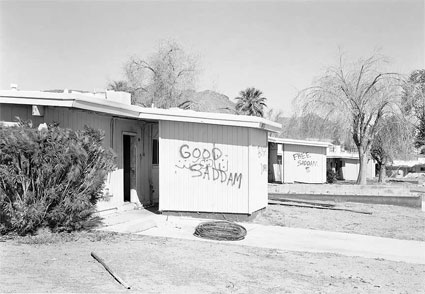 29 Palms: Security and Stabilization Operations, Graffiti
29 Palms: Security and Stabilization Operations, Graffiti
In 2003, An-My Lê was granted permission to photograph U.S. military training exercises in preparation for deployment to Afghanistan and Iraq. The series 29 Palms takes its name from the Marine base in southern California’s Mojave Desert where Lê photographed, in her distanced documentary style, American soldiers both rehearsing their own roles and playing the parts of their adversaries. Their practice includes dressing as Iraqi police and tagging former military housing with mock anti-American graffiti.
Found this video about her work on you tube:
Peter Piller collects images he finds in the filing cabinets of regional newspapers, police archives or other more-or-less public sources. By rearranging them in series and displaying them in frames he gives them a new purpose and a new meaning.
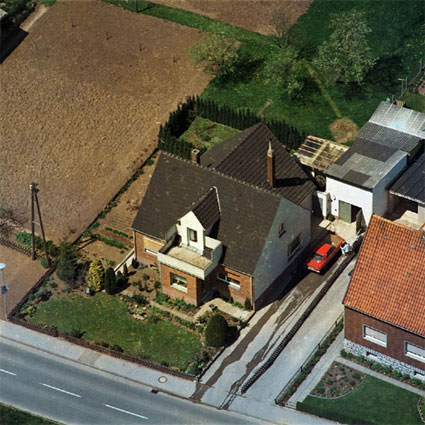 Autowäsche 7
Autowäsche 7
Von Erde schöner, the series he is showing in Madrid, has its origins in the archives of a company which, in the 1980´s, was seeking to commercially exploit the pride of German house owners. Colour aerial photographs of single family homes and the surrounding property were taken and offered, neatly framed, to the respective owners. In 2002, Piller came into the possession of 20,000 negatives of the pictures.
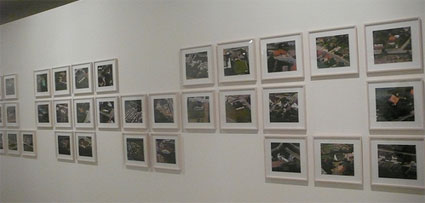
Unlike the company that often offered just a larger detail of the photo, avoiding unattractive things in the surroundings to make the house appear more attractive, Piller always uses the entire picture of the negative. By refraining from intervening in the image, interesting details emerge. Excavation or the foundations of another house under construction can be seen, for example.
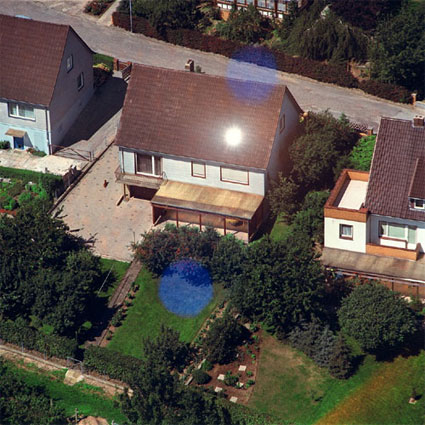 Verbindungsbilder 1, 2002-04
Verbindungsbilder 1, 2002-04
Piller arranged the aerial photographs according to the various criteria: some have shut Venetian blinds and other features indicating that the occupants are not home, others come with swimming pool, or show a person in front of house, birds are flying another series, etc. Of course, none of these elements played a role when the photos were originally taken.
At the Museo de Colecciones ICO in Madrid, until August 24.
